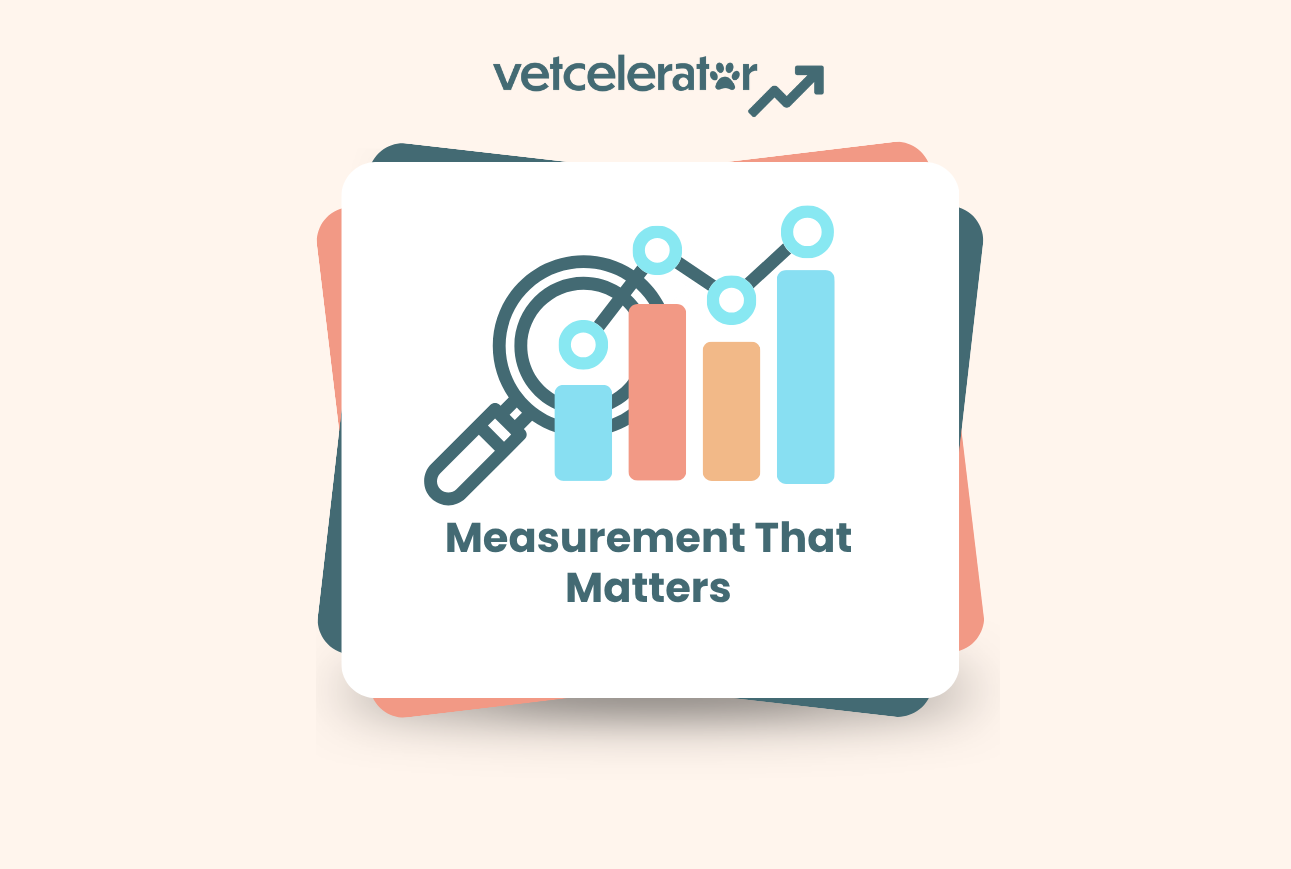
At Vetcelerator, we believe every business problem is a marketing problem. Our mission is founded on the premise that effective marketing, informed by data and strategy, can address operational, financial, and growth challenges across veterinary practices.
That’s why we deploy marketing professionals who understand the veterinary industry, not just in theory, but in the metrics that matter and the platforms that perform.
This blog series breaks down the core components of digital advertising for veterinary clinics. From defining goals to understanding ad platforms and interpreting data, our objective is to equip you with the clarity to make informed marketing decisions.
Here’s what’s ahead:
- Measurement That Matters: Tracking Conversions in Veterinary Marketing
- How First-Party Data Enhances Audience Insights for Veterinary Clinics
- Ad Campaign Types Explained: Choosing the Right Strategy for Your Veterinary Clinic
- When to Use High-Intent vs Awareness Campaigns in Veterinary Marketing
- Veterinary Clinics: How to Balance Awareness and High-Intent Ads
- Impression Share: What It Is and Why It Matters for Veterinary Clinics
- 5 Signs It’s Time to Increase Your Veterinary Marketing Budget
- Measurement in Action: Using Marketing Data to Guide Veterinary Growth
What Marketing for Veterinary Practices Means
The word “marketing” can be used very broadly, making it susceptible to misrepresentation without proper context.
It’s not uncommon for a vet clinic owner or practice manager to think of marketing as just “doing ads.” But marketing, when done right, is a system rather than a single tactic. Veterinary marketing is every touchpoint, every decision, and every message that moves someone from unaware to loyal.
You may have seen a popular video online that tries to define marketing using a circus analogy (if not, watch it right on this article!). Here’s how that framework translates into the veterinary industry:
- Market Research: If you’re exploring the pet population in your area, analyzing local demand for veterinary services, or reviewing competitor positioning, that’s market research.
- Advertising: Putting up a banner or running a paid Facebook ad that says, “New Veterinary ClinicOpening This Saturday!”—that’s advertising.
- Promotion: Handing out flyers at the local dog park or sponsoring a pet parade are promotional efforts.
- Publicity: When your clinic’s sponsorship gets featured on the evening news, that’s publicity.
- Public Relations: If the local news anchor praises your clinic on air or mentions bringing their own pet for a visit—that’s public relations.
- Market Segmentation: Targeting specific neighborhoods with a high concentration of pet owners or partnering with shelters and pet stores in those zones—that’s segmentation.
- Sales: When someone enters your clinic, engages with a friendly, informed team, has their questions answered, and commits to a care plan—that’s sales.
- Marketing: If all of the above is coordinated to support a defined goal, reinforce your brand, and drive measurable results, then that’s marketing.
Where Veterinary Digital Marketing Begins
Marketing for veterinary practices is about aligning every step of the client journey with a strategy that drives growth. Without clear direction, even the most well-designed campaigns can fall short.
For example, a practice manager gets excited about a marketing idea. Maybe they heard about a new Facebook ads campaign that’s working great for another clinic, so they jumped in headfirst. They spend three months and a few thousand dollars, then wonder why nothing seems different. The problem isn’t the Facebook ads. The problem is they never defined what “success” actually looks like for their clinic.
Before you choose platforms, design creatives, or set budgets, you need clarity on your goals. Are you trying to increase new client bookings? Fill gaps in your schedule? Promote a specific service line?
Goals & Measurement
If every business problem is a marketing problem, then the solution starts with clarity. Specifically, clarity around your goals and how success will be measured.
Digital marketing rarely fails due to poor execution; it fails because the goal was undefined or too broad from the outset. For veterinary practice owners, setting clear, measurable goals is what turns good intentions into an actionable strategy.
Start With the Right Questions
Before any creative is developed, platforms selected, or dollars spent, grab a pen (yes, actually write this down) and answer the following questions:
- What exactly do I want this campaign to achieve?
- How will I know if it’s working?
- What metric(s) directly reflect that goal?
- What tools am I using to measure?
Write the answers down. Be specific. Avoid generalities like “get more clients” or “increase visibility.” These are ideas, not goals.
If you just say, “I want to grow my clinic,” there’s no target, timeline, or way to measure progress. Are you looking for more patients? Higher revenue per client? Better retention? The more specific the goal, the easier it will be to measure the outcome and avoid wasted ad spend.
Set KPIs That Matter For Your Veterinary Clinic
Let’s take a specific goal that a clinic owner or practice manager might have.
“I want to increase new client bookings by 15% over the next 90 days through online appointment requests.”
This goal provides your marketing team or agency with a foundation to design a campaign and offers you a clear benchmark for success. Achieving the goal requires ongoing measurement tied to the right indicators.
You can use conversion tracking to align the right KPIs (Key Performance Indicators) to this objective throughout the veterinary digital marketing campaign lifecycle. These are some common metrics for vet clinic conversion tracking:
Click-Through Rate (CTR)
Measure how compelling your veterinary clinic ads are. A strong CTR indicates that your messaging and creatives are resonating with the right audience.
- Use CTR To: Optimize headlines, calls-to-action, and ad placements. If CTR is low, you’re likely targeting the wrong audience or using weak messaging.
Conversions (Appointment Requests)
The total number of users who submitted a request form or booked online.
- Use Conversions To: Track your core objective directly. Monitor weekly totals against your 90-day target to see if you’re on pace.
Conversion Rate (CVR)
The percentage of users who complete the desired action after clicking your ad or landing on your site.
- Use CVR To: Identify friction. If lots of people are clicking but not booking, there might be friction in your booking process.
Cost Per Conversion (CPC)
How much you’re paying for each appointment request.
- Use CPC to: Evaluate efficiency. A decreasing CPC with steady conversion volume indicates improved performance and better return.
Return on Ad Spend (ROAS)
The revenue generated per dollar spent on ads.
- Use ROAS To: Assess profitability. Even if you’re hitting your appointment targets, it matters whether those bookings are generating positive ROI. E.g., Your clinic gets 50 new appointments, but if they’re all just for $30 nail trims and you spent $2,000 in ads, that’s not a sustainable ROI.
Use Digital Marketing Metrics for Tracking Progress Over Time
Don’t wait 90 days to see if you’re on track. A 90-day goal should be broken into milestones. Utilize dashboards to track trends and adjust strategies in real time. If you’re behind pace after 30 days, consider that an opportunity to adapt targeting or refine ad copy.
Vetcelerator provides its customers with real-time dashboards that provide insights into the campaign’s performance. This also helps us understand realistic expectations for a campaign.
Marketing without measurement is just noise because you are just spending money and hoping for the best. However, when metrics are directly tied to your goals, your campaigns become structured, scalable, and built for growth.
Vet Marketing Performance Measurement Tools
Once goals are clearly defined, the next step is knowing how to measure progress. Success can be appropriately measured by understanding which tools provide the right insights for veterinary clinics and how to use them effectively. You don’t need to become a vet marketing specialist, but you do need to understand the basics of how to track your results.
Advertising Platforms
Search Ads (High-Intent)
Veterinary digital marketing campaigns through search ads target users actively looking for veterinary services. Success is measured here through conversion tracking metrics, such as appointment bookings, calls from ad extensions, or clicks to contact pages.
Meta Ads (Awareness / Low-Intent)
These reach users who aren’t actively searching but who match your ideal client profile. Success is measured over time: engagement rates, impressions, reach, and assisted conversions (visits or actions that follow ad exposure).
Analytics Platforms
Google Analytics
Tracks user behavior on your website, from the source of traffic to on-site actions. Define what success looks like (form submissions, calls, eCommerce sales) and configure goals or key events to track these outcomes.
Events & Key Events
These are specific actions on your site (e.g., “Appointment Request Submitted” or “Phone Number Clicked”). They help you tie user behavior directly to business outcomes.
Dashboards
Dashboards consolidate data from multiple sources into a single view. This gives you a real-time, visual snapshot of performance across campaigns and platforms. A good dashboard should include benchmarks and a clear data visualization of your campaign’s performance.
Google Business Profile (GMB)
Your clinic’s reputation and visibility live here. Reviews, Q&A, photos, and local search rankings all contribute to how often and how confidently potential clients choose your clinic. Track impressions, direction requests, and call clicks directly from your profile.
Website
Your website is a lead generation engine. Every page should serve a purpose. Track bounce rate, session duration, and, most importantly, conversion paths (i.e., the actions users take before booking or contacting you).
Customer Data & First-Party Insights
The most valuable measurement tool is your own customer data. Which marketing campaigns are bringing in clients who spend more? Which ones attract clients who stick around longer? Whether it’s revenue per client, lifetime value, or retention rates, you move from clicks to ROI.
Conclusion
You wouldn’t buy a new X-ray machine for your clinic without knowing if it would pay for itself, right? The same logic applies to digital veterinary marketing. Every dollar your clinic spends on marketing should be working toward a specific, measurable goal. And you should know within 30-90 days whether it’s working or not.
Every effective campaign starts with a clear definition of success. Without specific goals and accurate measurement, even the best creative and highest ad spend can miss the mark. Measurement is not a final step. It’s your starting point. And it’s how you go from running ads to running a business built for long-term growth. Vetcelerator partners with veterinary practices to bring precision to digital marketing. If you want campaigns that perform and metrics that matter, join with Vetcelerator to make sure every marketing dollar you spend is working as hard as you do.




